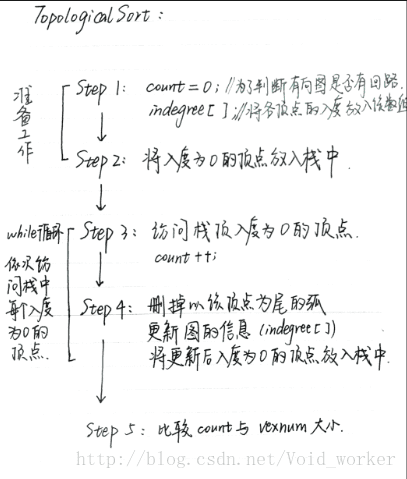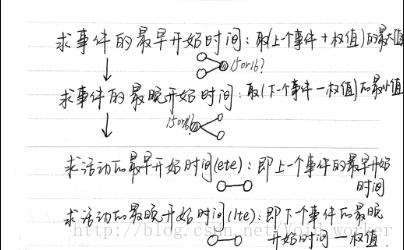数据结构--图--拓扑排序/关键路径/AOE/AOV
1.基本概念:
AOV网:用顶点表示活动,用弧表示活动间的优先关系的有向图称为顶点表示活动的网络(Activity On Vertex Network),简称AOV-网。
AOE网:在一个表示工程的带权有向图中,用顶点表示事件,用有向边表示活动,用边上的权值表示活动的持续时间,这种有向图的边表示活动的网,我们称之为AOE网(Activity On Edge Network)
{路径长度:路径上各个活动所持续的时间之和
关键路径:从源点到汇点具有最大长度的路径
关键活动:在关键路径上的活动}
拓扑排序:对一个有向图构造拓扑序列的过程。
关键路径:由于在AOE网中有些活动可以并行地进行,所以完成工程的最短时间是从开始点到完成点的最长路径的长度(这里所说的路径长度是指路径上各活动持续时间之和,不是路径上弧的数目)。路径长度最长的路径叫做关键路径。
2.算法实现思路
拓扑排序
从AOV网中选择一个入度为0的顶点输出,然后删去此顶点,并删除以此顶点为尾的弧,继续重复此步骤,直到输出全部顶点或者AOV网中不存在入读为0的顶点为止。
(拓扑排序的过程中,需要删除顶点,显然用邻接表会更加方便。考虑到算法过程中始终要查找入度为0的顶点,因此我们设置一个indegree数组,用来存放各顶点的入度数目。)

关键路径
拓扑排序主要是为解决一个工程能否顺序进行的问题,但有时我们还需要解决工程完成需要的最短时间问题。我们如果要对一个流程图获得最短时间,就必须要分析它们的拓扑关系,并且找到当中最关键的流程。这个流程的时间就是最短时间。
一个活动的最早开始时间= 最晚开始时间,则该活动是关键活动,活动间的路径是关键路径。



3.拓扑排序/关键路径 实现代码
拓扑排序
#include关键路径
#include